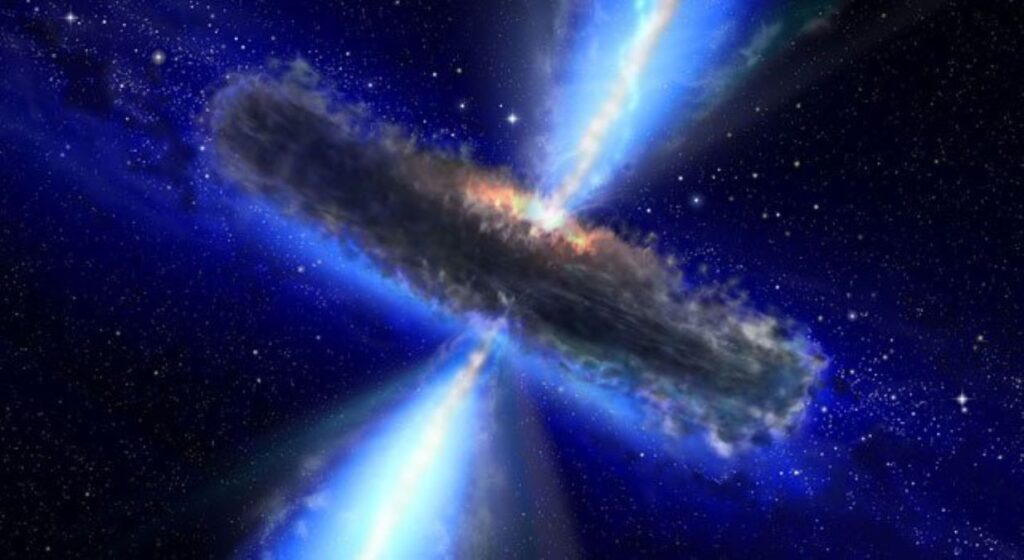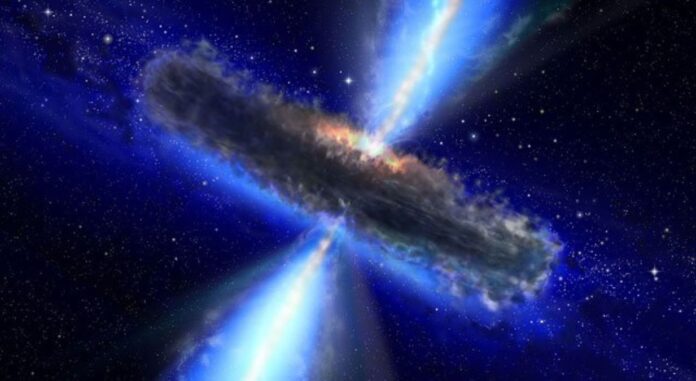
In a groundbreaking revelation, scientists have stumbled upon an astonishing reservoir of water within a black hole situated 12 billion light-years away. Picture this: an ocean confined within the heart of a cosmic phenomenon, more than a billion times bigger than the Sun or any planet in our solar system.
To put it simply, if you were to amass all the water encompassing our planet’s oceans and magnify it by 140 trillion, you’d barely scratch the surface of what was discovered in that black hole.
Now, you might be wondering, what exactly is a black hole? Well, envision it as an interstellar vacuum cleaner taking up anything unfortunate enough to stray too close, including light itself.
This particular black hole, referred to as a quasar, is a supermassive entity that consumes gas and dust while emitting very large amounts of energy into the vast expanse of space.
ALSO READ: There’s a Massive Space Rock With Horns Racing Towards Earth: Is It the Big Bang All Over Again?
A quasar is powered by an enormous black hole that steadily consumes a surrounding disk of gas and dust. As it eats, the quasar spews out huge amounts of energy. Both groups of astronomers studied a particular quasar called APM 08279+5255, which harbors a black hole 20 billion times more massive than the sun and produces as much energy as a thousand trillion suns.
According to NASA scientist Matt Bradford, who works at NASA’s Jet Propulsion Laboratory in Pasadena, California, water plays a crucial role in sustaining the quasar’s extremely large appetite.
“The environment around this quasar is very unique in that it’s producing this huge mass of water,” said Matt Bradford, “It’s another demonstration that water is pervasive throughout the universe, even at the very earliest times.”
POLL—Should the Government Increase Taxes on the Wealthy To Reduce Economic Inequality?
Bradford’s team made their observations starting in 2008, using an instrument called “Z-Spec” at the California Institute of Technology’s Submillimeter Observatory, a 33-foot (10-meter) telescope near the summit of Mauna Kea in Hawaii. Follow-up observations were made with the Combined Array for Research in Millimeter-Wave Astronomy (CARMA), an array of radio dishes in the Inyo Mountains of Southern California.
The second group, led by Dariusz Lis, senior research associate in physics at Caltech and deputy director of the Caltech Submillimeter Observatory, used the Plateau de Bure Interferometer in the French Alps to find water. In 2010, Lis’s team detected water in APM 8279+5255, observing one spectral signature. Bradford’s team was able to get more information about the water, including its enormous mass, because they detected several spectral signatures of the water.
Astronomers had long speculated about the existence of water vapor within the edges of our universe, yet finding it at such a crazy distance had remained difficult until now.
Now, this water isn’t idly loitering around this black hole; it’s in a constant state of flux, swirling and churning around like a whirlpool. The water present in this Black hole is a mind-boggling 140 trillion times the amount of water found in all the oceans of our planet.
ALSO READ: Japan Lunar Module Lands on the Moon Despite Broken Solar Panel
These scientists made use of advanced telescopes and instruments such as the Z-Spec and the Plateau de Bure Interferometer. Researchers directed their gaze towards a quasar called APM 08279+5255.. This quasar has a staggering mass of being 20 billion times greater than that of the Sun in our solar system, and its energy equivalent to a thousand trillion suns combined.
You Might Also Like:
“9-1-1” Actor Oliver Stark Condemns Homophobic Backlash to Character’s Gay Kiss
Hillary Clinton Faces Student Protest During Visit to Alma Mater
Fans Boo US Women’s Soccer Star at Atlanta Game
These Maya Angelou Quotes Will Inspire You Everyday


